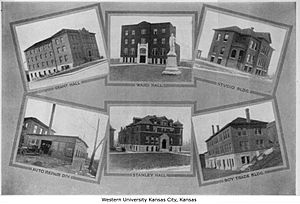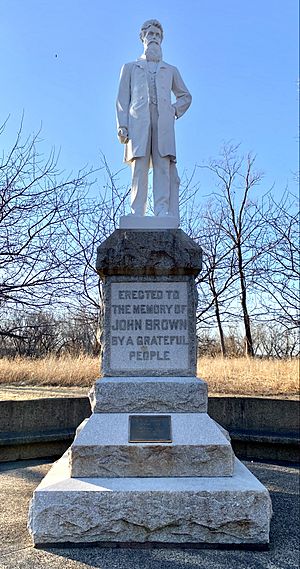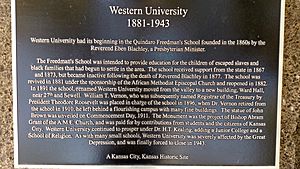Western University (Kansas) facts for kids

Western University in the early 1920s, with a statue of John Brown in front of Ward Hall
|
|
|
Former name
|
Quindaro Freedman's School |
|---|---|
| Type | Private |
| Active | 1865–1943 |
|
Religious affiliation
|
African Methodist Episcopal Church |
| Location |
,
,
US
39°08′59″N 94°39′35″W / 39.14967°N 94.65960°W |
Western University in Kansas was a special college for African Americans. It opened in 1865, right after the Civil War. At first, it was called the Quindaro Freedman's School. It was the first school for African Americans west of the Mississippi River. It was also the only one of its kind in Kansas.
In the early 1900s, the music school at Western University became very famous. Its singing group, the Jackson Jubilee Singers, toured all over the country. Many talented musicians studied here. Some, like Eva Jessye, Nora Douglas Holt, and Etta Moten Barnett, became pioneers in music.
The university also had an industrial department. This taught students useful skills for jobs, like carpentry and printing. Western University helped many African Americans get an education for several generations. It closed in 1943 because of money problems during the Great Depression. Today, none of its original buildings are still standing.
Contents
History of Western University
The very first classes that grew into Western University started in 1862. A man named Eben Blachley taught children of freed people in his home. The school was located in Quindaro, Kansas. This town was built on a bluff near the Missouri River. Later, Kansas City took over the Quindaro area.
Quindaro was founded in 1856 by people who wanted to end slavery, called abolitionists. It was also started by Wyandot Native Americans and free Black people. Settlers from New England also came to help Kansas become a free state. Quindaro was a stop on the Underground Railroad. This secret network helped enslaved people escape to freedom before and during the Civil War.
After the war, a group of white abolitionists started a school for freed people. These freed people had moved to Quindaro and the Kansas City area. In 1865, they officially opened the Quindaro Freedman's School. The state of Kansas began to give money to the school in 1867.
In 1872, the state gave more money to create a four-year program. This program trained teachers. Charles Henry Langston, a well-known activist and politician, became the principal. He was the grandfather of the famous poet Langston Hughes. Freed people believed that education was very important for their future.
The school faced money problems after 1873, so it had to take in fewer students. But Eben Blachley continued to support it. He gave 100 acres (0.40 km2) of his land to help the college. In the 1880s, many African Americans moved to Kansas. This helped the college become active again.
Later, the African Methodist Episcopal Church (AME) started helping the school financially. Quindaro added a program to train religious leaders. In 1891, they built Ward Hall, named after an AME Church bishop. In 1890, the college got its first African-American president.

Around 1911, students, teachers, and churches raised money to build a statue of John Brown. He was a famous abolitionist. This statue, even though it's old and damaged, still stands where the campus used to be.
Programs at Western University
In 1896, William Tecumseh Vernon, an AME minister, became president. He worked hard to get more money from the state. In 1899, he got approval and funds to add industrial education. This meant building many new buildings for these classes and for student housing.
Industrial Training
The industrial courses were like those at Booker T. Washington's Tuskegee Institute. Students learned skills like business, drafting, printing, carpentry, and tailoring. Later, they added blacksmithing and wheelwrighting. These skills helped students find good jobs. The campus grew with buildings for training with animals and a laundry. Later, a building for auto mechanics was added.
Music School Excellence
The music school became very strong after 1903. Robert G. Jackson started the Jackson Jubilee Singers. Fannie De Grasse Black taught pipe organ. From 1907 to 1940, this group was very popular. They toured the United States and Canada. They performed on the Chautauqua circuit, which helped raise money for the college. Their performances also helped keep African-American spiritual songs alive.
Orrin McKinley Murray, Sr., a historian and former student, wrote about the singers:
So great was their success in rendering spirituals and the advertising of the music department of Western University, that all young people who had any type of musical ambition decided to go to Western University at Quindaro.
The music school had many famous women alumni. They became important pioneers in music. These included Nora Douglas Holt, Eva Jessye, and Etta Moten Barnett. Nora Holt was a composer, music critic, and performer. Eva Jessye started her own choir in New York. She worked with famous composers like Virgil Thomson and George Gershwin. George Gershwin even chose her to direct the choir for his opera Porgy and Bess. Etta Moten Barnett became famous for singing the lead role of Bess in Porgy and Bess. Another early student was L. Viola Kinney, a composer and music teacher.
Western University's music program was highly praised in the early 1900s.
Western University at Quindaro, Kansas, was probably the earliest black school west of the Mississippi and the best black musical training center in the Midwest for almost thirty years during the 1900s through the 1920s.
In 1915, the university started its own monthly newspaper called University Pen Point.
Closing of the University
The Great Depression in the 1930s made it hard for the university to get money. It also faced more competition from other schools. Because of these challenges, Western University finally closed in 1943.
Today, only the cornerstones of the first two main buildings remain. Some buildings were destroyed by fire, and others were torn down. The last historic faculty houses were removed in the late 1900s. The statue of John Brown is still there, and a small memorial area has been built around it.



